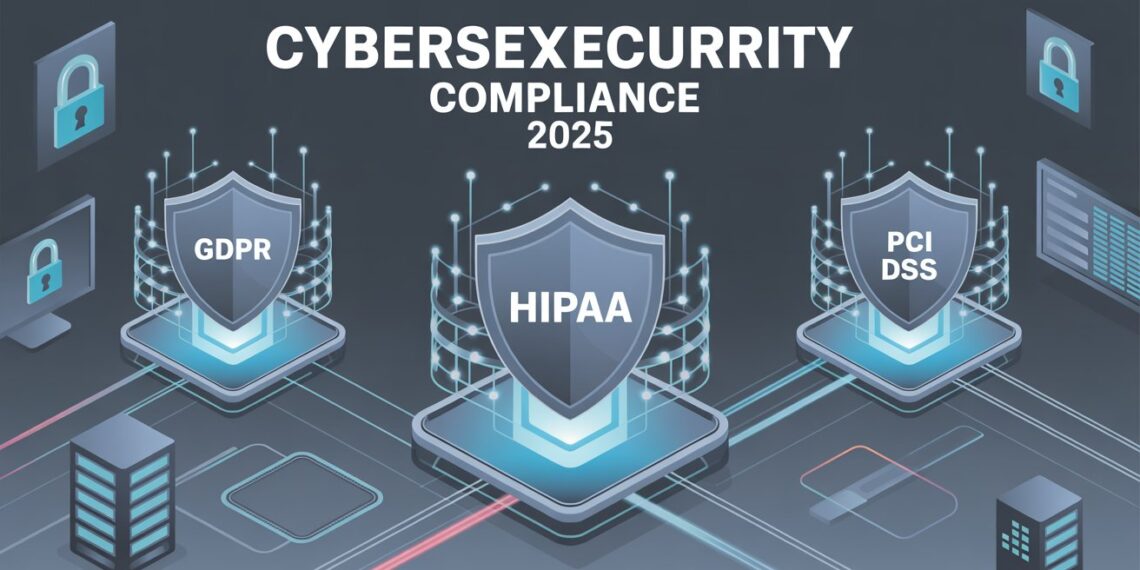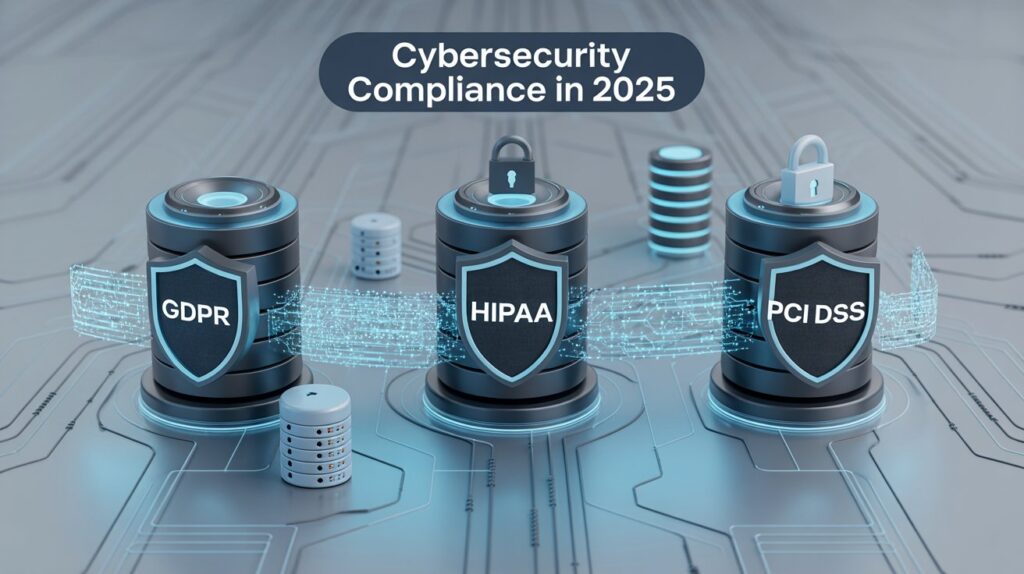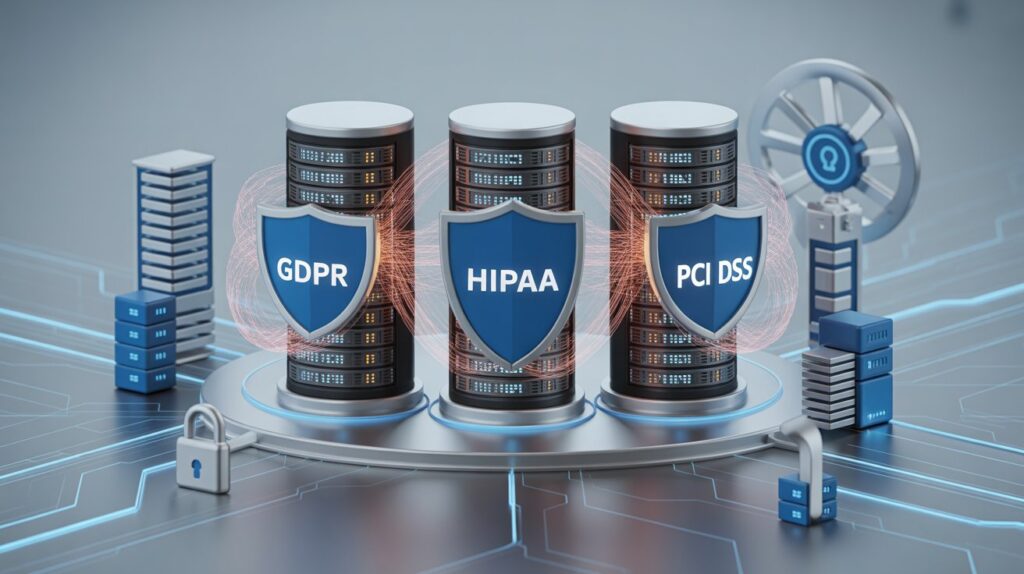In today’s digital-first world, data protection isn’t just good practice—it’s a legal and operational necessity. Businesses handle sensitive personal, financial, and healthcare data daily, making cybersecurity compliance one of the most pressing concerns of the modern enterprise. Three major frameworks dominate the global regulatory landscape: the General Data Protection Regulation (GDPR), the Health Insurance Portability and Accountability Act (HIPAA), and the Payment Card Industry Data Security Standard (PCI DSS).
Understanding how these standards differ, overlap, and apply to your organization is essential for avoiding costly penalties and maintaining customer trust. In this guide, we’ll dive deep into Cybersecurity Compliance: GDPR vs. HIPAA vs. PCI DSS, breaking down their key requirements, areas of conflict, and strategies for achieving unified compliance.
What Is Cybersecurity Compliance?
Cybersecurity compliance refers to the process of following laws, regulations, and frameworks designed to safeguard digital assets and sensitive information. These standards dictate how organizations should collect, process, store, and protect data from unauthorized access or breaches. Compliance ensures not only data security but also legal protection, business continuity, and customer confidence.
Each regulation—GDPR, HIPAA, and PCI DSS—focuses on a specific type of data and industry, but they all share a common goal: protecting sensitive information in an increasingly interconnected world.
Understanding the Three Major Standards
1. General Data Protection Regulation (GDPR)
The GDPR is the European Union’s landmark data privacy law, enacted in 2018. It governs how organizations collect, process, and store the personal data of EU residents, regardless of where the organization is based.
Key Principles:
-
Lawfulness, fairness, and transparency: Data collection must have a clear legal basis and be communicated transparently to users.
-
Purpose limitation: Data should only be used for its original intended purpose.
-
Data minimization: Only necessary data should be collected.
-
Accuracy and integrity: Data must remain accurate and protected from unauthorized access or corruption.
-
Accountability: Organizations must demonstrate compliance through documentation, policies, and audits.
Applicability:
GDPR applies to any organization—inside or outside the EU—that processes the personal data of EU citizens.
Penalties:
Non-compliance can lead to fines up to €20 million or 4% of global annual revenue, whichever is higher.
2. Health Insurance Portability and Accountability Act (HIPAA)
Enacted in 1996, HIPAA is a U.S. law designed to protect protected health information (PHI). It applies to healthcare providers, insurance companies, and their business associates.
Key Rules:
-
Privacy Rule: Governs how PHI is used and disclosed.
-
Security Rule: Sets administrative, technical, and physical safeguards for electronic PHI (ePHI).
-
Breach Notification Rule: Requires organizations to notify individuals and authorities of data breaches.
Applicability:
HIPAA applies to healthcare entities and third-party service providers handling patient data, such as billing companies, cloud storage providers, and telehealth platforms.
Penalties:
Violations can result in fines from $100 to $50,000 per incident, with a maximum annual penalty of $1.5 million—and potential criminal charges for serious negligence.
3. Payment Card Industry Data Security Standard (PCI DSS)
PCI DSS is a global security standard developed by major credit card brands (Visa, Mastercard, American Express, Discover, JCB). It aims to protect cardholder data and prevent fraud in payment processing.
Core Requirements:
-
Install and maintain a secure network.
-
Protect cardholder data with encryption.
-
Implement strong access control measures.
-
Monitor and test networks regularly.
-
Maintain an information security policy.
Applicability:
Any organization that stores, processes, or transmits payment card information must comply—whether it’s an e-commerce business or a physical retailer.
Penalties:
Non-compliance may lead to fines ranging from $5,000 to $100,000 per month, suspension of payment processing privileges, and reputational damage.
GDPR vs. HIPAA vs. PCI DSS: Side-by-Side Comparison
Aspect |
GDPR |
HIPAA |
PCI DSS |
|---|---|---|---|
Data Covered |
Personal data (any identifiable information) |
Protected Health Information (PHI) |
Cardholder data |
Jurisdiction |
European Union (applies globally to EU residents’ data) |
United States (healthcare sector) |
Global (any organization processing card data) |
Enforcement Body |
EU Data Protection Authorities |
U.S. Department of Health & Human Services (HHS) |
PCI Security Standards Council |
Primary Goal |
Protect individuals’ privacy and personal rights |
Secure healthcare data and patient privacy |
Prevent credit card fraud and secure payment systems |
Breach Notification Deadline |
Within 72 hours |
Within 60 days |
Immediately to payment brands/acquirers |
Fines |
Up to 4% of global revenue |
Up to $1.5 million annually |
$5,000–$100,000 per month |
Certification |
None (self-regulated) |
None (self-attestation and audits) |
Required for certain merchant levels |
Applies To |
Any entity processing EU data |
Covered entities and business associates |
Merchants and payment processors |
Areas of Overlap and Conflict
Despite targeting different sectors, these frameworks share many common cybersecurity principles:
Common Ground
-
Access Control: Restricting data access to authorized personnel only.
-
Encryption: Protecting data at rest and in transit.
-
Audit Trails: Maintaining logs to trace data activity.
-
Breach Notification: Reporting incidents promptly.
-
Employee Training: Ensuring staff understand compliance requirements.
Potential Conflicts
-
Data Retention: HIPAA requires retaining medical records for years, while GDPR’s “right to be forgotten” demands deletion upon request.
-
Jurisdictional Scope: Multinational organizations must navigate GDPR’s global reach and HIPAA’s U.S.-centric focus simultaneously.
-
Legal Basis for Processing: GDPR requires explicit consent, whereas HIPAA allows data use for treatment or billing without additional consent.
Organizations that fall under multiple frameworks—such as healthcare providers processing EU patients’ payments—must carefully align their data policies to avoid contradictions.
Achieving Unified Compliance
Achieving compliance with multiple regulations can seem daunting, but with a unified cybersecurity framework, it’s possible to streamline the process.
1. Conduct a Comprehensive Risk Assessment
Start by identifying all data types you handle—personal, financial, and medical—and map them to relevant compliance obligations.
2. Implement Universal Security Controls
Focus on controls that satisfy multiple frameworks simultaneously:
-
Encryption (GDPR, HIPAA, PCI DSS)
-
Multi-factor authentication
-
Regular vulnerability testing
-
Access controls and audit logging
3. Maintain Robust Documentation
Create detailed policies for data handling, breach response, and access management. Documentation is vital for demonstrating accountability during audits.
4. Train Employees Regularly
Human error remains the leading cause of data breaches. Regular training ensures awareness of compliance responsibilities across departments.
5. Partner with Certified Vendors
Ensure cloud providers, payment processors, and third-party vendors meet equivalent compliance standards. Under GDPR, they are considered “data processors” and share legal responsibility.
6. Conduct Ongoing Monitoring and Audits
Compliance is continuous—not a one-time task. Use automated tools to track compliance posture, detect anomalies, and generate audit-ready reports.
Real-World Example: Overlapping Compliance in Healthcare Payments
Consider a U.S. telemedicine company serving European patients and processing online payments. Such an organization must:
-
Follow HIPAA for patient health data,
-
Adhere to GDPR for EU user data, and
-
Comply with PCI DSS for credit card processing.
This overlapping obligation requires integrated data governance policies—where a single encryption and logging system supports all three frameworks simultaneously. Clear documentation and vendor due diligence ensure no compliance gap exists across jurisdictions.
The Cost of Non-Compliance
Ignoring these standards can have devastating consequences:
-
Financial Penalties: GDPR fines in the millions, HIPAA penalties up to $1.5M annually, and PCI DSS fees per month.
-
Legal Consequences: Potential lawsuits, loss of certifications, and government investigations.
-
Reputational Damage: Breaches often make headlines, eroding customer confidence.
-
Operational Disruption: Payment suspension, license revocation, or data processing bans.
Investing in compliance is significantly cheaper than dealing with the fallout of non-compliance.
Future Trends in Cybersecurity Compliance
The cybersecurity compliance landscape is evolving rapidly. Here are some trends shaping 2025 and beyond:
-
Zero Trust Architecture: Frameworks increasingly recommend zero trust principles—verifying every user, device, and transaction.
-
AI Governance: As AI adoption grows, new compliance challenges emerge around algorithmic transparency and data ethics.
-
Cross-Border Harmonization: Efforts are underway to align global data protection standards for multinational businesses.
-
Cloud and Remote Work Security: The shift to hybrid work requires stronger cloud compliance controls, especially for healthcare and finance sectors.
Organizations that proactively adapt to these trends will not only remain compliant but gain a competitive advantage through better data governance.
FAQs on Cybersecurity Compliance: GDPR vs. HIPAA vs. PCI DSS
1. Do small businesses need to comply with these regulations?
Yes. Any organization that handles EU data (GDPR), health data (HIPAA), or payment card data (PCI DSS) must comply—regardless of size.
2. Can one compliance framework substitute for another?
No. Each standard governs a specific type of data. However, shared security practices (encryption, monitoring) can satisfy requirements across multiple frameworks.
3. How often should compliance audits be performed?
At least annually, or whenever there are significant system or policy changes.
4. What’s the biggest mistake companies make with GDPR, HIPAA, or PCI DSS?
Assuming compliance is a one-time project. Continuous monitoring, documentation, and staff training are critical for ongoing compliance.
5. How can organizations simplify compliance?
By adopting an integrated compliance management system, using automation tools, and appointing a Data Protection Officer (DPO) or Compliance Officer.
Conclusion
In a world where data is a critical asset, compliance is no longer optional—it’s foundational to trust, resilience, and business success. While GDPR, HIPAA, and PCI DSS each focus on different domains, they share the same ultimate goal: protecting sensitive information from misuse and breach.
Understanding the nuances of Cybersecurity Compliance: GDPR vs. HIPAA vs. PCI DSS helps organizations design unified, efficient, and legally sound data protection strategies. The best approach isn’t to view these frameworks as isolated obligations, but as complementary tools for building a secure, privacy-respecting digital environment.
Organizations that invest in strong cybersecurity controls today will not only avoid penalties but also gain a powerful reputation for integrity and customer trust in the years ahead.












